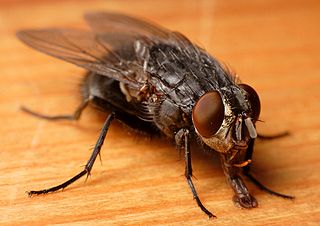The Romanian Orthodox Metropolia of the Americas is an autonomous Eastern Orthodox metropolis of the Romanian Orthodox Church. The Metropolia covers the territory of the United States and Canada.

Nanorana vicina is a species of frog in the family Dicroglossidae. It is found in the Himalayan front of northern India and Pakistan. Its natural habitats are high-altitude rivers, springs, and other running water in open forest and grassland habitats. There seem not to be any major threats to this species. Behavior, habitat use patterns and morphometric traits of the overwintering tadpoles of this species has been found to be influenced by check dams built in the montane streams.
The Tagula honeyeater is a species of bird in the family Meliphagidae. It is endemic to Papua New Guinea.

The Central Antillean slider is a species of turtle in the family Emydidae. The species is found on three islands in the West Indies: Hispaniola, Great Inagua, and Puerto Rico.

Calliphora vicina is a member of the family Calliphoridae, which includes blow flies and bottle flies. These flies are important in the field of forensic entomology, being used to estimate the time of a person's death when a corpse is found and then examined. C. vicina is currently one of the most entomologically important fly species for this purpose because it arrives at and colonizes a body following death in consistent timeframes.
Butta la luna is an Italian television series.
Euphaedra vicina, or the glossy white-striped forester, is a butterfly in the family Nymphalidae. It is found in Nigeria, Cameroon, the Democratic Republic of the Congo and Uganda. The habitat consists of forests.

Vicina was a town on the Danube used as a tradepost (Emporia) by the Republic of Genoa, being part of the Genoese trade empire between the 13th and 14th century. At one time, it was the most flourishing port of the maritime Danube, but its importance declined with the development of other ports such as Kilia and Brăila. Although many locations have been proposed by both historians and archeologists as the remains of Vicina, it is still unknown where this town was located.
Scopula vicina is a moth of the family Geometridae found in Nigeria.
Caradrina vicina is a moth of the family Noctuidae. It was described by Staudinger in 1870. It is found from Central and Southeastern Europe, eastern and central Anatolia, and Western to Central Asia. The habitat consists of grasslands.

Valiano is a frazione of the town of Montepulciano in the Province of Siena, on the border between the regions of Umbria and Tuscany. It was an ancient feudal castle which, due to its strategic position and the role played by the family of Del Pecora, was an outpost of Val di Chiana of great historical importance from thirteenth century until the establishment of Grand Duchy of Tuscany.

Agelaia vicina is a species of wasp in the genus Agelaia. They are neotropical social wasps known to have the largest colony sizes and nest sizes among social wasps, with some colonies exceeding over one million individuals. They are predators of land arthropods, consuming both insects and spiders alike. Recent sperm morphology studies have shown that although Vespidae belong to the superfamily Vespoidea, A. vicina may be more phylogenetically related to Apoidea.
Cristodesisa is a genus of longhorn beetles of the subfamily Lamiinae, containing the following species:
Cristodesisa perakensis is a species of beetle in the family Cerambycidae. It was described by Stephan von Breuning in 1959. It is known from Malaysia.

The neighbouring miner bee is a species of miner bee in the family Andrenidae. Another common name for this species is the neighborly miner. It is found in North America.
Seguyola vicina is a species of fungus gnat, first described by Loïc Matile in 1990, of the family Lygistorrhinidae. Its type locality is in Cameroon. There are no subspecies.
Chelonoidis niger vicina, commonly known as the Cerro Azul giant tortoise, Iguana Cove tortoise or the Isabela Island giant tortoise, is a subspecies of Galápagos tortoise endemic to Isabela Island in the Galápagos.






